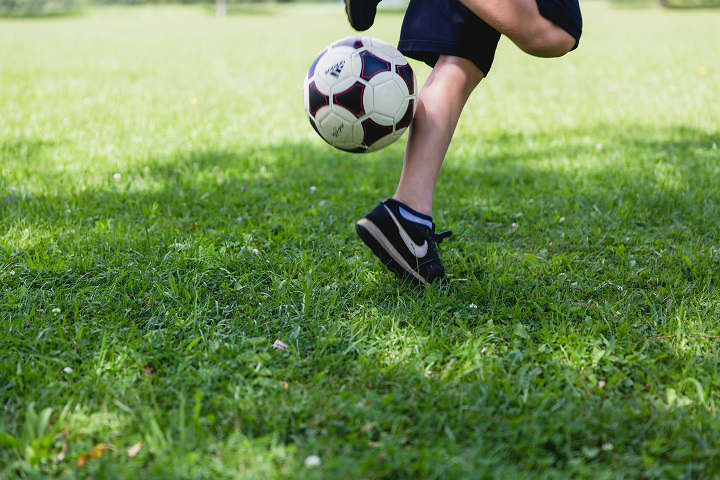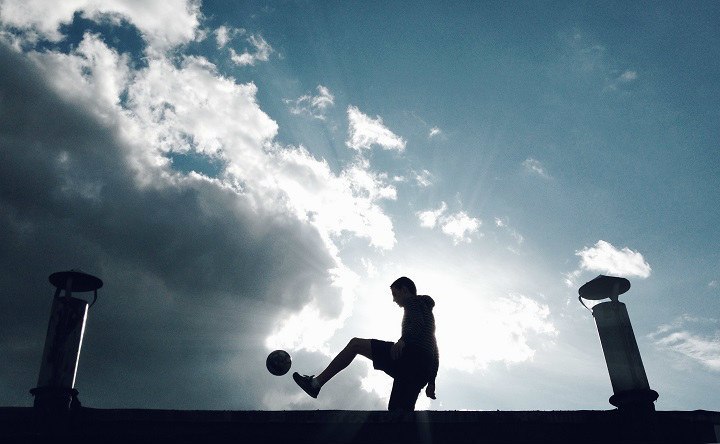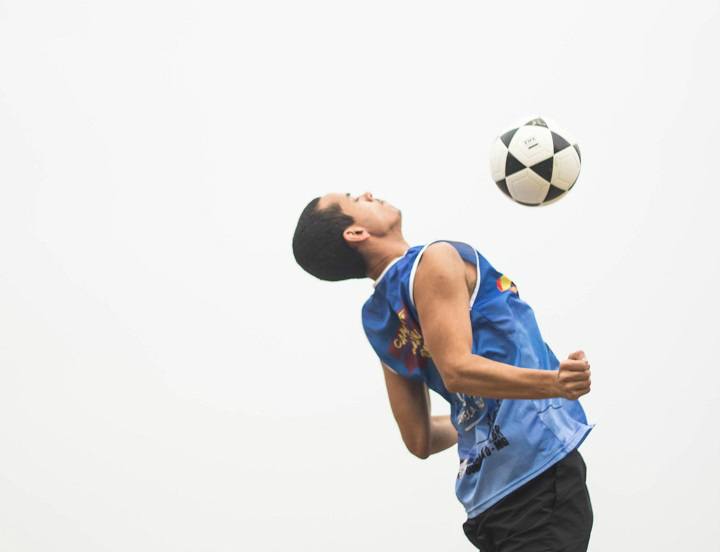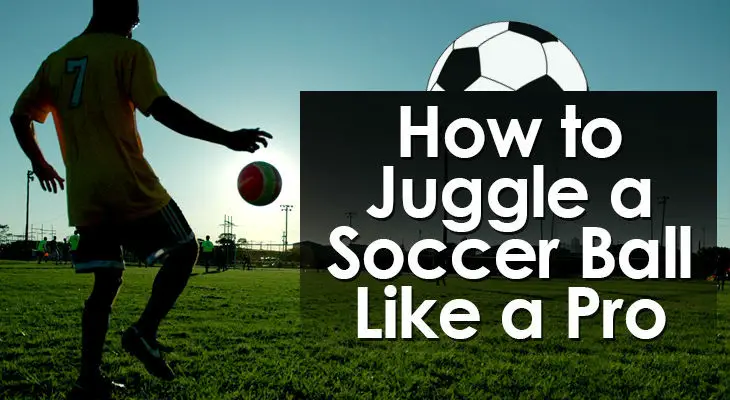How to Juggle a Soccer Ball Like a Pro
Whether you’re having fun with your friends before training or using it to get out of a tricky situation on the pitch, knowing how to juggle a soccer ball is a useful skill to have.
Not only is it fun to be able to keep the ball in the air, you’ll also see improvements in your ball control as well as your technique.
Some players use their juggling skills to showboat...
But there are several scenarios throughout a game where this skill can be useful.
Whether you’re flicking a skillful header back to the goalkeeper, cushioning a pass to your teammate, or plucking the ball out of the sky with the tips of your toes…
Learning how to juggle a soccer ball can help improve your game in a number of ways.
Before you start, it’s important to remember that while it will be extremely difficult in the beginning, with a little practice you’ll be juggling in no time.
Let’s get started...

How to Juggle a Soccer Ball:
Step #1 - Drop, Kick, Catch
The easiest way to start is with the ball in your hands.
Holding the ball in front of you at chest height, practice dropping the ball and kicking it back up to the same area without allowing the ball to touch the ground.
This allows you to practice making contact with the ball when your foot is angled correctly.
Keep doing this until you’re confident striking the ball and it’s ending up somewhere between your waist and chest when at its peak.
Make sure you can comfortably do this with both feet before moving on.
Step #2 - Drop, Bounce, Kick, Catch
Now, let’s add a bounce.
Drop the ball from chest height once again…
But instead of kicking the ball before it hits the ground, allow the soccer ball to bounce.
After the ball has bounced up and is beginning to descend again, use your foot to tap the ball into the air hard enough for it to reach chest height.
Then catch the ball and start again until you’re comfortable with this initial kick.
You need to make sure you’re not kicking the ball too high or too low as this will make it much harder for you to learn how to juggle a soccer ball.
Once again, make sure you can do this with both feet before moving on.
Step #3 - Drop, Bounce, Kick, Kick, Catch
Next up, add a second kick.
Drop the ball from chest height (same as before) and allow it to bounce.
When the ball is descending after the bounce, tap the ball into the air to chest height as you’ve now practiced many times before...
But this time when it’s falling back down, attempt to kick the ball up into the air for a second time instead of catching the ball.
After your second kick in the air, catch the ball again.
Step #4 - Drop, Bounce, Kick, Kick, Kick…
Now we’re starting to get serious.
Once you’ve mastered the first two taps off the bounce, it’s time to attempt kicking the soccer ball into the air as many times as possible.
This requires you to maintain focus and balance while using good technique.
It’s also the stage when many players will start alternating feet while juggling. Being able to use both feet effectively is incredibly important if you want to juggle the soccer ball for more than a few seconds.
Just make sure you’re weak foot is positioned at the correct angle when contact is made and be ready to move around and adjust your position.
With practice, you’ll be able to alternate the foot you use and soon after you´ll be using everything from your chest and head, to thigh and heel to keep the ball in the air!
Step #5 - Flick, Kick, Kick, Kick...
Now let’s look at starting the juggle when the ball is on the ground.
To do this, place your dominant foot on top of a stationary soccer ball in front of you and then gently roll your foot down it. This will make the ball roll back towards you.
Once you have got the ball rolling towards your stronger foot, place your toes on the ground so that the ball rolls up your laces.
With your foot underneath the ball, you can now flick the ball up into the air.
As usual, you need to make sure you have control of the ball so don’t flick the ball up too high or too far out in front of you.
The goal is to flick the ball directly up to waist or chest height.
From there, juggle the ball as you’ve practiced earlier and keep going for as long as possible!

Head, Shoulders, Knees, and Chest
Once you’re able to keep the ball up in the air for more than a few seconds, you’ll notice times where it would be useful to be able to control the ball with other parts of your body.
Let’s work on that now…
When practicing, don’t forget you can always toss the ball in the air to make things easier before adding the move to your arsenal of skills.
Knees
The natural progression from using your feet is to next use your knees.
When juggling, raise your knee up in front to create a flat surface on your thigh which the ball can bounce on.
Your thigh must be parallel with the ground when contact is made.
If the angle is wrong, the ball will either:
- Bounce forward and hit the ground
- Roll down your thigh and hit your body
Using your knees and thighs is useful when you’re juggling to keep the ball under control.
As with your feet, practice alternating between your thighs when practicing.
Once you feel confident doing this, start using combinations of your feet and thighs so that you can use both while juggling the soccer ball.
Head
Using your head while juggling is more complicated than your knees and feet, but it’s worthwhile learning how to do it as there will be times when it’s necessary.
When juggling with your head, the best technique is to angle your face upwards so that your eyes are focused on the ball and then hit the ball with your forehead to keep it in the air.
This only requires a small amount of power.
Simply use your neck to push upwards as the ball descends, nodding it gently into the air.
Make sure that the ball rises straight up into the air as even a small angle can make it harder to get into position in time to head it again and keep the ball under control.
Chest
Another common part of the body that people use to control the ball during matches and while they’re juggling is the chest.
Controlling the ball with your chest is an important skill to have on the pitch when your teammate plays a high ball in your direction and you want to bring it down safely.
To get the ball in the air, either kick it up or throw it up at an angle above you.
You must position yourself below the falling ball and then stick out your chest and push your shoulders back while arching your back backwards.

This will give your chest a larger surface area on which to control the ball and the angle of your chest will help the ball remain in the air.
If you attempt to control the ball with a flat chest, you will see that it simply slides down your body and rolls off without slowing down.
This makes it much harder to control which is why your posture is so important when chesting the soccer ball.
Once again, incorporate this skill into your juggling routine.
Shoulders
Once you’ve become confident with the other parts of your body, add in your shoulders!
While it can feel slightly unorthodox, some players like to show off a bit by using their shoulders to highlight they’ve mastered this difficult move.
Since your shoulders aren’t flat, it’s harder to use them to juggle the ball.
You need to angle them in the direction you want the ball to go when contact is made.
Hunch the shoulder that’s going to hit the ball upwards and this should pop the ball up above and you’ll be able to continue juggling or play on.
But make sure you keep your eyes on the ball and only make contact with your shoulder as any other part of your arm will be called as a foul.
10 Small Tips to Remember When Learning How to Juggle a Soccer Ball
1. Don’t give up.
2. Deflate the ball a little if needed.
3. Focus on your balance and concentrate on the ball.
4. Practice as often as possible.
5. Use multiple parts of your body.
6. Use different parts of your feet.
7. Add tricks once you become confident.
8. Vary the height you kick the ball up.
9. Practice with friends.
10. Play soccer tennis!
Conclusion
That’s all the knowledge you need!
Whether you’re learning how to juggle a soccer ball just for fun or to use the moves involved during live games, juggling is a great skill to learn.
It’s immensely satisfying being able to keep the ball in the air for as long as you want while mucking around by yourself or with friends.
With practice and dedication to improve, you’ll soon be effortlessly tapping the ball from foot to foot, thigh to thigh, and eventually using your chest, head, and shoulders.

